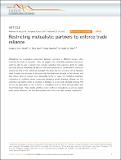Files in this item
Restricting mutualistic partners to enforce trade reliance
Item metadata
| dc.contributor.author | Wyatt, Gregory | |
| dc.contributor.author | Kiers, Erica | |
| dc.contributor.author | Gardner, Andy | |
| dc.contributor.author | West, Stuart | |
| dc.date.accessioned | 2016-02-04T12:10:17Z | |
| dc.date.available | 2016-02-04T12:10:17Z | |
| dc.date.issued | 2016-01-27 | |
| dc.identifier | 237835679 | |
| dc.identifier | f93a5b1e-b493-4f46-b5c5-256017526ed0 | |
| dc.identifier | 84955481015 | |
| dc.identifier | 000369021500012 | |
| dc.identifier.citation | Wyatt , G , Kiers , E , Gardner , A & West , S 2016 , ' Restricting mutualistic partners to enforce trade reliance ' , Nature Communications , vol. 7 , 10322 . https://doi.org/10.1038/ncomms10322 | en |
| dc.identifier.issn | 2041-1723 | |
| dc.identifier.uri | https://hdl.handle.net/10023/8128 | |
| dc.description.abstract | Mutualisms are cooperative interactions between members of different species, often involving the trade of resources. Here, we suggest that otherwise- cooperative mutualists might be able to gain a benefit from actively restricting their partners’ ability to obtain resources directly, hampering the ability of the restricted partner to survive and/or reproduce without the help of the restricting mutualist. We show that: (i) restriction can be favoured when restricting individuals increase their comparative advantage and thus receive more favourable terms of trade; (ii) restriction maintains cooperation in conditions where cooperative behaviour would otherwise collapse; and (iii) restriction can lead to either an increase or decrease in a restricted individual’s fitness. We discuss the applicability of this scenario to mutualisms such as those between plants and mycorrhizal fungi. These results identify a novel conflict in mutualisms as well as several public goods dilemmas, but also demonstrate how conflict can help maintain cooperation. | |
| dc.format.extent | 7 | |
| dc.format.extent | 431804 | |
| dc.language.iso | eng | |
| dc.relation.ispartof | Nature Communications | en |
| dc.subject | QH301 Biology | en |
| dc.subject | T-NDAS | en |
| dc.subject.lcc | QH301 | en |
| dc.title | Restricting mutualistic partners to enforce trade reliance | en |
| dc.type | Journal article | en |
| dc.contributor.sponsor | NERC | en |
| dc.contributor.sponsor | The Royal Society | en |
| dc.contributor.institution | University of St Andrews. School of Biology | en |
| dc.contributor.institution | University of St Andrews. Centre for Biological Diversity | en |
| dc.identifier.doi | 10.1038/ncomms10322 | |
| dc.description.status | Peer reviewed | en |
| dc.identifier.grantnumber | NE/K009524/1 | en |
| dc.identifier.grantnumber | UF100023 | en |
This item appears in the following Collection(s)
Items in the St Andrews Research Repository are protected by copyright, with all rights reserved, unless otherwise indicated.

